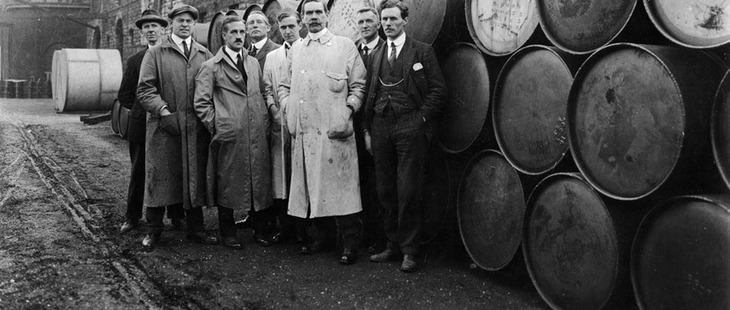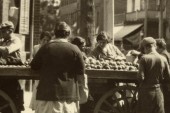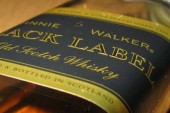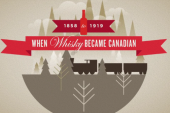
(City of Toronto Archives, Fonds 1583) As we reported last week, Toronto’s food processing sector has without much notice eclipsed car manufacturing as the region’s largest industry. In this, the city has returned to its roots. If today Toronto needs the food industry to keep its economic engine running, the same could be said of the city in the 19th century – although then the brewery and abattoir existed more by fluke than design. Remarkably, whisky was the first product produced in Toronto explicitly for the Canadian market. Up until the 1870s the country’s economy was almost exclusively oriented towards Europe: what Europe wanted, Europe got; what Canada wanted, Europe might provide. And it showed: the economic, political and geographic arrangement of the country was tailored to facilitate the movement and trade of specific staple commodities. Europe wanted cod, so the east coast turned into a decentralized cooperative fishery; the aristocracy wanted beaver hats, so the entire continent rearranged its economic trading lines from north-south to east-west; the new English working classes needed bread, and Upper Canada was turned into a vast farmland, crisscrossed by canals and roads. As profitable as this was for European traders, the majority of those who lived in Canada suffered by it. Leaving aside the appropriation of indigenous labour and land, the massive amounts of work that went into preparing and harvesting the land simply broke the lives of many. Legions of Irish workers cut waterways through mosquito-infested swamps or blasted through rock with virtually no compensation, let alone calories – often with guns literally pointed at their heads. Small landowners were compelled to sell to the same merchant year after year (no matter how low a price they offered) because of long and complex chains of debt coupled with the threat of debtors’ prison. Farm labourers hoped to find enough work in the summer to pay for their food over the winter or, if they were lucky, to find an abandoned farm off the beaten track. This is all by way of saying that there was considerable demand for the one cheap luxury product available: whisky. After weeks or months of hard work, the only refuge from the overseer, the banker or the merchant was the tavern. Sprouting up concomitantly with new roads, by the 1830s the province was home to more than one thousand inns. Serving whisky and a brew that approximated beer, these places functioned as the only public social space available to men (and, it should be noted, a few women). From whence did all the whisky come? In the early Canadian farming economy, whisky functioned as an alternative currency. Instead of payment in cash, people sometimes took payment in spirits. Which, in retrospect, was probably a rational economic decision: when banks closed and inflation skyrocketed you could do worse than to hold a substance that everyone wanted dear. By the 1830s, mills were sprouting all across the province. Farmers took their wheat and corn to be milled for market, while the miller keep a cut and claimed whatever waste material was left over. From this almost all of the millers brewed whisky. Though small, these were not fly by night operations; the province regulated and licensed them, and more often than not the miller hired a distiller. Still, this was a only side business for most. Until 1837. It’s then that a small mill known as Gooderham and Worts (Worts was long dead and so it was run by Gooderham and his sons), located at the mouth of the Don River, suddenly became inundated with wheat it couldn’t sell profitably. As these things too often happen for farmers, the market crashed the same year as they had a bumper crop. As most mills and farmers cut their losses, Gooderham decided to shift his business almost exclusively to distilling. And so, the first major Canadian distillery was born. Supply, meet demand. Gooderham’s business grew exponentially. By the late 1870s Gooderham’s and Worts was the city’s largest company and, indirectly, its largest employer. Their distillery was the world’s largest, producing in excess of two million gallons of spirits each year (or, in a more modern unit of measurement, over ten million 26ers). 31,000 acres of farmland directly supplied the company with rye, wheat, corn, oats, barley and hops. And given that their whisky business started out as a way to profitably deal with an externality, the excess product was used to maintain the largest herd of cattle outside of Texas. These were also kept on site. The good times wouldn’t last. By the 1880s whisky was no longer the low product of the peasant farmer or the canal worker: Gooderham and Worts’ rye was sold the world over, making it Toronto’s first global company. But the emerging temperance movement and changing social mores would soon put the pinch on the lucrative Canadian market. From such lofty heights, the company would eventually resort to smuggling operations to keep its business afloat. Part two of Whiskytown coming next week.














